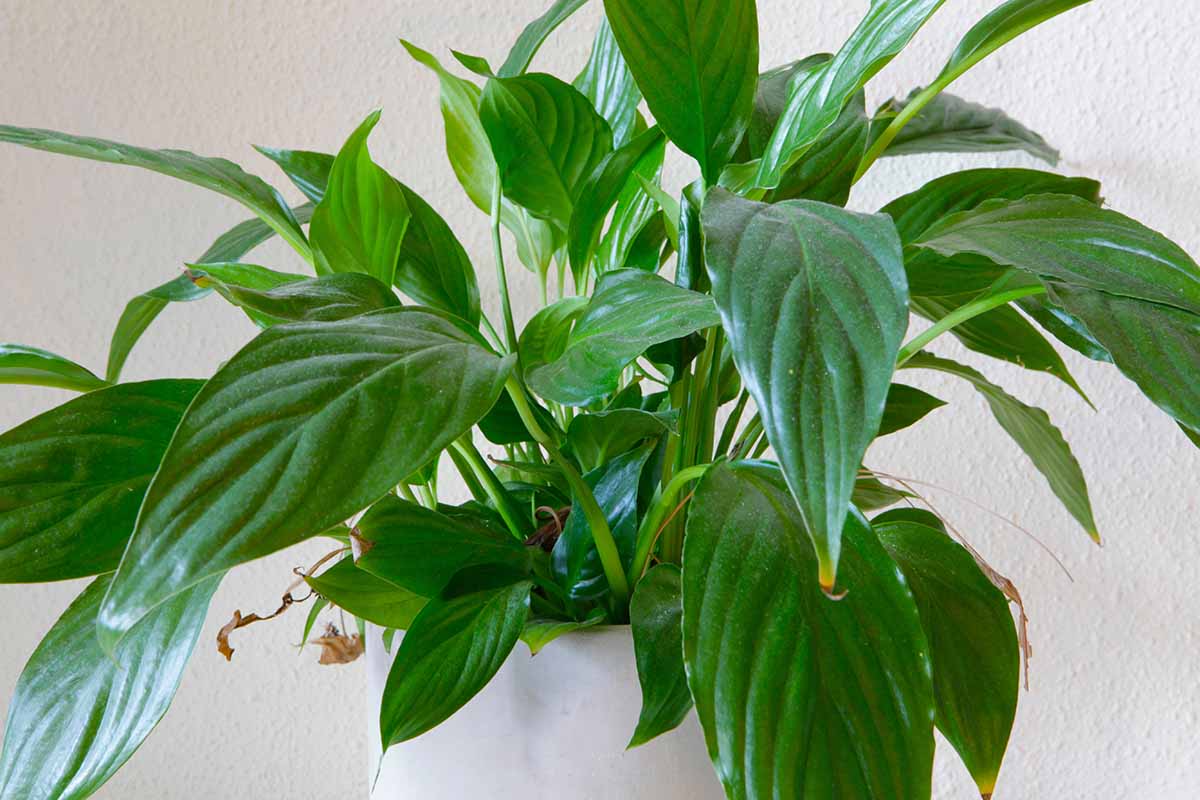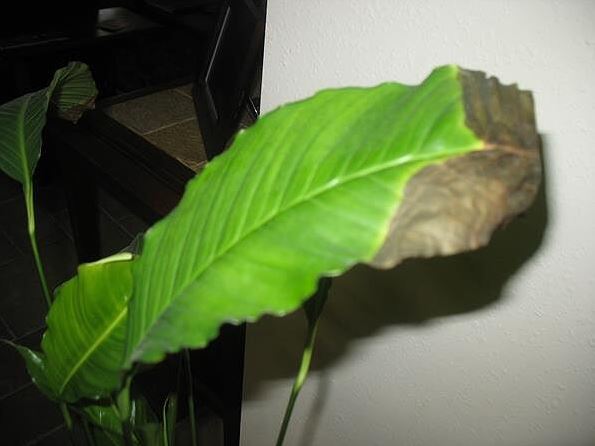Low humidity is typically the cause of brown tips on peace lily leaf tips. Peace lilies are tropical plants that have adapted to high humidity levels. Indoor dry air depletes the moisture from the leaves, turning the tips brown.

The brown tips on peace lilies’ leaves are a symptom of stress and can be caused by a variety of factors, including underwatering, sunburn, too much fertilizer, and pollutants in tap water. Low humidity is the most prevalent cause of brown leaf tips on peace lilies.
If your peace lily has brown tips, you can still save it by simulating its natural environment by misting the leaves to increase humidity, maintaining a daytime temperature between 68°F and 85°F, waiting until the soil surface is dry before watering deeply, and pruning off the brown tips with a pair of sharp pruners.
If you want to know why the tips of your peace lily’s (SPATHIPHYLLUM X ‘WALLISII’) leaves are brown and how to save the plant, keep reading.
Table of Contents
Peace Lily with Brown Tips
Low humidity and underwatering are typically to blame for peace lilies’ brown leaf tips. Native to wet tropical woodlands, peace lilies are. If indoor heating or air conditioning causes the air to become overly dry, this depletes the leaves of moisture, resulting in the browning of the leaf tips.
Low humidity can be brought on by a number of things, including open doors or drafty locations, and it is especially prevalent in winter since interior heating dries the air out too much for peace lilies to survive.
Peace lilies’ leaves droop and develop dark leaf tips if the soil surrounding their roots dries out.
The soil must be evenly moist and well-draining for peace lilies. The leaf tips of the peace lily turn brown if it is not watered frequently enough or very gently enough.
Since peace lilies are indigenous to tropical woods in Central and South America, where they thrive in shade or brilliant indirect light and are shielded from direct sunshine, they adapt well to growing indoors.
On the other hand, if the peace lily is set on a window sill, the direct light may scorch the leaves and make the tips brown.
As well as being sensitive to hard water, tap water’s fluoride and chlorine can also cause brown tips on peace lilies.
Since peace lilies thrive in warm tropical woodlands and like temperatures close to room temperature, high temperatures are typically not an issue.
The leaf tips, however, can turn brown owing to the abrupt disparity in temperatures if the peace lily is too close to an indoor heating source or if the temperature rapidly changes.
It’s also important to keep in mind that peace lilies prefer nights that are 10 degrees colder than days.
Due to interior heating in Winter, temperatures are frequently higher in the evening than they are during the day. This is not the peace lily’s typical temperature cycle and can result in leaf tips turning brown as a symptom of stress.
During the growing season, peace lilies often only need 2 or 3 applications of fertilizer at half intensity due to their sensitivity to fertilizer.
The leaf tips turn dark if fertilizer is given too frequently, heavily, or in the winter.
The peace lily occasionally shifts its focus from caring for its leaves to spring and summer flowering, which can result in the leaves turning brown.
Save a Peace Lily with Brown Leaf Tips

Should I Cut The Brown Tips Off my Peace Lily Leaves?
Trim the brown leaf tips off the peace lily with a good pair of pruners to restore its beauty. To produce a natural shape, mimic the leaf’s shape. To restore the peace lily’s healthy appearance, the brown tips should be cut off to encourage new growth.
As long as you use the recommended methods of maintenance, such as spraying the leaves frequently to promote humidity, the peace lily should continue to have healthy, green leaves.
(Read how often to water peace lilies in my article.)
Peace Lily Yellow Leaves with Brown Leaf Tips
Peace lilies with brown tips and yellow foliage typically have brown tips due to excessive exposure to sunlight. Under the shade of a tropical forest’s canopy and away from the light, peace lilies naturally flourish. The yellowing and browning of leaves caused by excessive sunshine.
When exposed to moderate sun, peace lily leaves often turn yellow. However, when exposed to intense direct sunlight, the leaves burn brown, with the leaf tips also turning brown.
To avoid having their leaves turn yellow with brown tips, peace lilies should be kept in bright light or shade. Their leaves are especially sensitive to direct sunshine.
Low nitrogen levels in the soil can also be a factor in peace lily leaves turning yellow with brown tips.
The root system can deplete the soil of nutrients if the peace lily has been in the same container for a long period (or if the soil is exceptionally deficient in nutrients), which causes the peace lily to droop and its bottom leaves to turn yellow with brown tips.
The presence of excessive moisture close to a peace lily’s root system is another factor contributing to its leaves turning yellow with brown tips.
Because marshy, soggy soil encourages the conditions for root rot and fungal diseases, peace lilies require well-draining soil and cannot tolerate it.
Overwatering, compacted soils that are hard to drain, or pots without foundation drainage holes can all result in soggy soil.
Empty any saucers and trays that may be under your container as well because they could collect extra water around the peace lily’s base and lead to soggy soil conditions.
How to Save Peace Lilies with Yellow Leaves and Brown Tips

- Place your peace lily in a location with strong, indirect light. To stop further fading or brown tips, keep peace lily leaves out of any direct sunlight.
- Mist the leaves and give the peace lily a healthy drink. Direct sunlight can dry a plant, diminish humidity, and cause the leaves to droop. The peace lily doesn’t risk root rot when given a thorough watering every 7 days during active development and every 10–14 days during winter dormancy. While it is healing, mist the leaves every day or use a humidifier to produce a humid microclimate that resembles that of its native tropical environment.
- Retrim any yellow leaves and brown leaf tips. Trimming off the individual leaf tips won’t hurt the peace lily. Instead of just cutting the tip off with an abrupt flat end to the leaf, trim the brown tips with two cuts at an angle using a sharp pair of pruners.
- Pruning back the yellow leaves shouldn’t be done until you can notice active growth. The peace lily is not necessarily immediately in danger from the burned area of the yellow leaves, and the plant may experience unnecessary stress if too many leaves are removed at once, even if they are only partially damaged. Your peace lily will become much more resilient if you notice it healing and sprouting new growth. then trim the entire leaf back to the plant’s root system. This aids in promoting fresh, green growth and enhancing the peace lily’s beauty.
If the peace lily has been in the same pot for a while (and you haven’t fertilized it), and the lower leaves are becoming yellow and the tips are going brown, then this is typically due to nutritional deficiencies in the soil, in which case:
- In the spring and summer, when the plants are actively growing, use a general houseplant fertilizer at half intensity. It is crucial to stress that peace lilies are more sensitive to fertilizer than the majority of houseplants, which is why using fertilizer at half intensity is so crucial. After using the fertilizer, the peace lily should start to recuperate and exhibit signs of vitality, which should assist to lessen a drooping aspect.
- Reduce any leaves that are yellowing or have brown tips. Normally, as leaves turn yellow, they lose their green appearance; however, fertilizer application should encourage a lot of fresh green growth. When the fresh green leaves begin to appear, remove any yellowing leaves by pruning them down to the base and trimming the brown tips with a good pair of pruners.
Peace lily leaves drooping and becoming yellow with brown tips are most likely caused by overwatering or poor drainage if the potting soil feels damp/bogged at the base and is saturated rather than just equally moist (feel the soil at the bottom of the pot through the drainage holes in the base). which would mean:
- Reduce the amount of watering and let the soil surface dry in between applications. The peace lily’s typical watering needs are met by watering every seven days, which also reduces the risk of root rot.
- Repot the peace lily if the potting soil is not draining quickly because of compaction. To enhance drainage and create a more porous soil structure, use fresh potting soil and enrich it with grit or perlite.
- Make sure the peace lily is placed in a pot with drainage holes in the bottom, and make sure to frequently clear any saucers or trays that may be under the pot. Water will collect around the roots of the peace lily if it cannot drain correctly, having the same effect as overwatering in that it will cause the leaves to turn yellow and droop with brown tips.
The peace lily probably has root rot if the soil is soggy and all the leaves have turned yellow. At this stage, even with assistance, saving the peace lily may be too tough.
To learn how to save a fading peace lily, see my post.
Key Takeaways:
- Low humidity from air conditioning or indoor heating is typically the cause of brown tips on peace lilies. The wet tropical forests are a good home for peace flowers. The peace lily’s leaves lose moisture indoors due to the dry air, which causes the tips of the leaves to brown.
- Brown tips on peace lilies can be caused by overwatering and inadequate drainage. Peace lilies require well-draining, consistently moist soil to grow. The first indication of stress is the browning of the leaf tips when the soil is overly soggy as a result of excessive watering.
- Too much direct sunshine causes peace lilies to turn yellow with brown tips. Peace lilies naturally grow in the shade of a forest canopy and have very delicate leaves. The peace lily’s leaves burn yellow in the sun, and the tips of the leaves turn brown from sunburn.
- A peace lily with brown tips can be revived by misting the leaves to enhance humidity, placing it in bright indirect light, thoroughly watering the soil, and pruning off the brown tips with a sharp pair of pruners.
